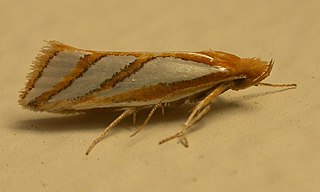
Thudaca mimodora is a moth of the family Depressariidae. It is found in Australia, where it has been recorded from New South Wales, Queensland, the Australian Capital Territory and Victoria.
The Hypertrophinae are a subfamily of small moths in the family Depressariidae. The subfamily was described by Thomas Bainbrigge Fletcher in 1929.

Thudaca is a moth genus of the family Depressariidae.
Thudaca calliphrontis is a moth in the family Depressariidae. It was described by Edward Meyrick in 1893. It is found in Australia, where it has been recorded from South Australia.
Thudaca campylota is a moth in the family Depressariidae. It was described by Edward Meyrick in 1893. It is found in Australia, where it has been recorded from Western Australia.
Thudaca crypsidesma is a moth in the family Depressariidae. It was described by Edward Meyrick in 1893. It is found in Australia, where it has been recorded from South Australia, Victoria, Tasmania and Western Australia.
Thudaca cymatistis is a moth in the family Depressariidae. It was described by Edward Meyrick in 1893. It is found in Australia, where it has been recorded from Western Australia.

Thudaca haplonota is a moth in the family Depressariidae. It was described by Edward Meyrick in 1893. It is found in Australia, where it has been recorded from Western Australia.

Thudaca heterastis is a moth in the family Depressariidae. It was described by Edward Meyrick in 1893. It is found in Australia, where it has been recorded from Western Australia.
Thudaca ophiosema is a moth in the family Depressariidae. It was described by Edward Meyrick in 1893. It is found in Australia, where it has been recorded from Western Australia.
Thudaca orthodroma is a moth in the family Depressariidae. It was described by Edward Meyrick in 1893. It is found in Australia, where it has been recorded from Western Australia.
Thudaca stadiaula is a moth in the family Depressariidae. It was described by Edward Meyrick in 1893. It is found in Australia, where it has been recorded from Western Australia.
Thudaca trabeata is a moth in the family Depressariidae. It was described by Edward Meyrick in 1893. It is found in Australia, where it has been recorded from New South Wales, South Australia, Western Australia and Tasmania.
Thudaca circumdatella is a moth in the family Depressariidae. It was described by Francis Walker in 1865. It is found in Australia, where it has been recorded from New South Wales.
Thudaca obliquella is a moth in the family Depressariidae. It was described by Francis Walker in 1864. It is found in Australia, where it has been recorded from New South Wales, Queensland, the Australian Capital Territory, Tasmania and South Australia.


